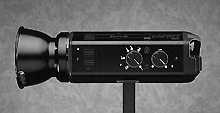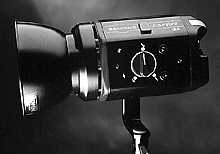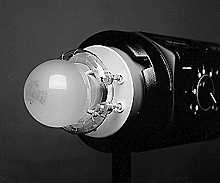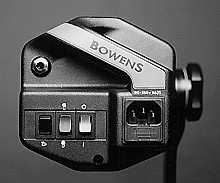
Bowens Esprit Flash
The name stands head and shoulders above all others in the field of
electronic flash. That name is Bowens. Bowens manufactured what was, until
it was discontinued, the UK's most popular range of monoblocs. Other
manufacturers may have been able to make other claims, and may well have
found favour with particular photographers, but more people chose Bowens
Prolites than any of the alternative offerings. That in itself is a very
reassuring fact. Add Bowens' membership of the KJP group, and the
consequent exceptional availability that this affords, and you have a
sure-fire winner.
However, being at the top of the tree means everybody else will set their
sights on your crown and, in some cases, will move heaven and earth to
steal a few percent of your market share.
Enter the Esprit
 On the grounds that attack is the best form of defence, just over a year
ago Bowens sought to strengthen its position by replacing the aging
Prolites with a new monobloc design, the Esprit. That range has been added
to ever since, and now comprises four units rated from 125J to 1000J and
with prices from �200 to �580 (excluding VAT).
On the grounds that attack is the best form of defence, just over a year
ago Bowens sought to strengthen its position by replacing the aging
Prolites with a new monobloc design, the Esprit. That range has been added
to ever since, and now comprises four units rated from 125J to 1000J and
with prices from �200 to �580 (excluding VAT).
A summary of the monoblocs' specifications is given in the table below.
For reference, specifications are included for the old Prolites 82, 100
and 120 - the first and last being equivalent in rating to the new Esprits
500 and 1000. To date, there is no new equivalent for the old 750J Prolite
100.
| ESPRIT | PROLITE |
|---|
| 125 | 250 | 500 | 1000 | 82 | 100 | 120 |
|---|
| RATING (J) | 125 | 250 | 500 | 1000 | 500 | 750 | 1000 |
|---|
| MIN. POWER | 1/4 | 1/4 | 1/32 | 1/32 | 1/8 | 1/8 | 1/16 |
|---|
| DURATION (s) | 1/2000 | 1/1100 | 1/500 | 1/1300 | 1/660 | 1/500 | 1/1500 |
|---|
| RECYCLING (s) | 0.9 | 1.4 | 1.4 | 2.6 | 2.4 | 2.6 | 2.8 |
|---|
| NOTE. Flash duration is the time to half peak brightness,
T(0.5), and refers to full power. Recycling time is also given at full
power. |
|---|
As the table shows, in almost all respects, the newer units are better
specified than their older equivalents. They are also lower priced.
According to Bowens, this has been achieved by the use of more efficient
manufacturing methods rather than any reduction in either build quality or
performance. Encouragingly, this does indeed seem to be the case in
reality. Another plus point is that the new Esprits feature flash
inhibiting circuits that prevent accidental firing before full power is
reached.
Comparative minus points are thin on the ground: the most obvious is the
lack of a car battery adaptor (previously offered for the Prolites 82 and
100). A consistent minus point is that Bowens' literature gives the
monoblocs' ratings in fictitious "w/s" or "W/S" units, while the more
recent brochures compound matters by quoting "�K", which is technically
wrong. Bowens are not alone - Systems Imaging makes the same mistakes in
its literature; Bowens manages to get the nomenclature right in its
Operating Instructions booklets.
 The feature that Bowens have made most of on the new Esprits is their
side-panel location of the flash output and modelling lamp brightness
controls. This has been done, in Bowens' own words, "for maximum ease of
adjustment no matter how you position the light." Well, yes and no. For
maximum ease of use you will probably want the controls near the camera,
to tweak the values either by eye or in response to test Polaroids. If
this sounds familiar, you would most likely be better off not using
monoblocs at all, but using generator packs instead. That, however, is
another story.
The feature that Bowens have made most of on the new Esprits is their
side-panel location of the flash output and modelling lamp brightness
controls. This has been done, in Bowens' own words, "for maximum ease of
adjustment no matter how you position the light." Well, yes and no. For
maximum ease of use you will probably want the controls near the camera,
to tweak the values either by eye or in response to test Polaroids. If
this sounds familiar, you would most likely be better off not using
monoblocs at all, but using generator packs instead. That, however, is
another story.
Bowens are not the first to think of putting the controls on the side of
a monobloc: some Multiblitz heads had the same feature (as well as a
remote control option) but at considerably higher prices.
For this test, only the two most popular Esprits, the 250 and the 500,
were tested. Immediate impressions were very good: the units look good and
feel good too. Personally, I think it is a shame that they are supplied
without reflectors, but at least this allows users to select their own
preferred type without wasting money on something that isn't wanted. What
is very good, however, is the provision of a sync lead with every unit.
You can never have too many sync leads!
 The two models share the same dimensions, which the brochure lists as a
145mm diameter and a 362mm length. Unlike last month's finding Elinchrom
and Prolinca published specs, Bowens' figures are accurate. The length
takes into account the rear handle, flash tube and modelling lamp, and the
protective travelling cap too. The diameter is the greatest width
measurement, referring to the longest diagonal across the angular body,
which is actually closer to 125mm square with sliced corners. Weights are
2.9kg and 3.4kg - more or less par for the course for 250J and 500J units
in general but considerably heavier than identical power Elinchrom units.
The two models share the same dimensions, which the brochure lists as a
145mm diameter and a 362mm length. Unlike last month's finding Elinchrom
and Prolinca published specs, Bowens' figures are accurate. The length
takes into account the rear handle, flash tube and modelling lamp, and the
protective travelling cap too. The diameter is the greatest width
measurement, referring to the longest diagonal across the angular body,
which is actually closer to 125mm square with sliced corners. Weights are
2.9kg and 3.4kg - more or less par for the course for 250J and 500J units
in general but considerably heavier than identical power Elinchrom units.
Neat design touches include space to store a spare fuse inside the
pull-out fuse holder itself and colour coding that identifies each
monobloc type (purple for the 250 and green for the 500; the 125 is blue
and the 1000 is red). Another nice idea is the moulded finger grip on the
inside face of the handle. This doesn't quite work in practice, however,
owing to the fact that it seems to have been set for a right hand grip,
whereas in practice the right hand would be loosening and tightening the
locking wheel while the left hand was adjusting the angle. In this respect
I would even suggest that the handle is on the wrong side of the rear
panel - but this really is getting very picky indeed!
 Practical tests suggest that the output range of the Esprit 500 is not
quite the five �-stops claimed, but rather about 1/3 �-stop less. Equally,
intermediate settings cannot be exact with continuously adjustable
controls because they are always a matter of aligning the knob against
marks on the chassis. From a practical point of view, the most frustrating
aspect is the need to dump excess power manually when decreasing output.
This is a tedious operation. I have been told that offering continuous
output control makes auto-dumping impossible, but I find this hard to
accept. Maybe it is simply not economic on equipment that is so keenly
priced.
Practical tests suggest that the output range of the Esprit 500 is not
quite the five �-stops claimed, but rather about 1/3 �-stop less. Equally,
intermediate settings cannot be exact with continuously adjustable
controls because they are always a matter of aligning the knob against
marks on the chassis. From a practical point of view, the most frustrating
aspect is the need to dump excess power manually when decreasing output.
This is a tedious operation. I have been told that offering continuous
output control makes auto-dumping impossible, but I find this hard to
accept. Maybe it is simply not economic on equipment that is so keenly
priced.
Recycling times are a shade longer than claimed, but not significantly
so. The flash inhibiting circuitry seems to function perfectly, with no
variation noted in measured flash brightness at constant power. The 250
and 500 share the same modelling lamp (either a 275W No 1 photoflood or a
250W Halostar). There is, however, no balancing of modelling lamp
brightness against the actual output of different units (as is provided on
Systems Imaging monoblocs). When set to full power, the Esprit 250's
modelling brightness is the same as a similarly set Esprit 500, but the
latter will then give a flash that is twice as bright. This difficulty can
be overcome in a crude way by fitting a 150W Photocrescenta bulb to a
lower-power head.
Bowens' approach to the question of modelling illumination is more
flexible than that of some other manufacturers, but results in what could
be seen as some omissions from the control panel. There is no automatic
proportional modelling, or either maximum or minimum brightness at the
touch of a switch. The modelling lamp knob can be rotated to its extreme
settings very easily, but proportional modelling would have been useful,
especially if combined with a an overall half-power switch to allow kits
with two different head powers to be mixed.
In truth, as may be gathered from the minor nature of the criticisms
raised, the Esprits are very hard to fault. First impressions last to the
end: they look good, they feel good, and by golly, they are good. Best of
all, the reflector fitting is that familiar design from the old Prolites.
There's no doubt about it: the UK's most popular flash monoblocs have been
made even better.
Aesthetic/Ergonomic Design: Very Good
Range of Accessories: Excellent
Capital and Running Costs: Very Good
Lighting Quality: Very Good
Overall: Esprits are without serious failings and have numerous points that
recommend them. For many users, the Bowens name and KJP back-up could
prove decisive. It is hard to imagine anybody regretting buying Bowens.
John Tarrant
Back to February 96 Contents
 The feature that Bowens have made most of on the new Esprits is their
side-panel location of the flash output and modelling lamp brightness
controls. This has been done, in Bowens' own words, "for maximum ease of
adjustment no matter how you position the light." Well, yes and no. For
maximum ease of use you will probably want the controls near the camera,
to tweak the values either by eye or in response to test Polaroids. If
this sounds familiar, you would most likely be better off not using
monoblocs at all, but using generator packs instead. That, however, is
another story.
The feature that Bowens have made most of on the new Esprits is their
side-panel location of the flash output and modelling lamp brightness
controls. This has been done, in Bowens' own words, "for maximum ease of
adjustment no matter how you position the light." Well, yes and no. For
maximum ease of use you will probably want the controls near the camera,
to tweak the values either by eye or in response to test Polaroids. If
this sounds familiar, you would most likely be better off not using
monoblocs at all, but using generator packs instead. That, however, is
another story.

 On the grounds that attack is the best form of defence, just over a year
ago Bowens sought to strengthen its position by replacing the aging
Prolites with a new monobloc design, the Esprit. That range has been added
to ever since, and now comprises four units rated from 125J to 1000J and
with prices from �200 to �580 (excluding VAT).
On the grounds that attack is the best form of defence, just over a year
ago Bowens sought to strengthen its position by replacing the aging
Prolites with a new monobloc design, the Esprit. That range has been added
to ever since, and now comprises four units rated from 125J to 1000J and
with prices from �200 to �580 (excluding VAT).
 The two models share the same dimensions, which the brochure lists as a
145mm diameter and a 362mm length. Unlike last month's finding Elinchrom
and Prolinca published specs, Bowens' figures are accurate. The length
takes into account the rear handle, flash tube and modelling lamp, and the
protective travelling cap too. The diameter is the greatest width
measurement, referring to the longest diagonal across the angular body,
which is actually closer to 125mm square with sliced corners. Weights are
2.9kg and 3.4kg - more or less par for the course for 250J and 500J units
in general but considerably heavier than identical power Elinchrom units.
The two models share the same dimensions, which the brochure lists as a
145mm diameter and a 362mm length. Unlike last month's finding Elinchrom
and Prolinca published specs, Bowens' figures are accurate. The length
takes into account the rear handle, flash tube and modelling lamp, and the
protective travelling cap too. The diameter is the greatest width
measurement, referring to the longest diagonal across the angular body,
which is actually closer to 125mm square with sliced corners. Weights are
2.9kg and 3.4kg - more or less par for the course for 250J and 500J units
in general but considerably heavier than identical power Elinchrom units.
 Practical tests suggest that the output range of the Esprit 500 is not
quite the five �-stops claimed, but rather about 1/3 �-stop less. Equally,
intermediate settings cannot be exact with continuously adjustable
controls because they are always a matter of aligning the knob against
marks on the chassis. From a practical point of view, the most frustrating
aspect is the need to dump excess power manually when decreasing output.
This is a tedious operation. I have been told that offering continuous
output control makes auto-dumping impossible, but I find this hard to
accept. Maybe it is simply not economic on equipment that is so keenly
priced.
Practical tests suggest that the output range of the Esprit 500 is not
quite the five �-stops claimed, but rather about 1/3 �-stop less. Equally,
intermediate settings cannot be exact with continuously adjustable
controls because they are always a matter of aligning the knob against
marks on the chassis. From a practical point of view, the most frustrating
aspect is the need to dump excess power manually when decreasing output.
This is a tedious operation. I have been told that offering continuous
output control makes auto-dumping impossible, but I find this hard to
accept. Maybe it is simply not economic on equipment that is so keenly
priced.